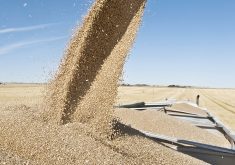Fed cattle continue weak
Due to the holiday-shortened week, active trade did not take place until Aug. 4, said Canfax.
There was a wide range in pricing. A few cattle traded at higher prices, but most were at levels similar to late the previous week of $65-$67 per hundredweight live and $110-$112 dressed.
By the afternoon of Aug. 4, packers had their fill and were again off the market.
The week’s averages were down $2.75 per cwt. on steers and $2.25 lower on the heifers.
Read Also

Soybean market still figuring out implications of China-U.S. pact
Soybean futures had a muted reaction to the U.S. trade deal with China as the market tries to figure out the nuances of the deal.
Volumes reported by Canfax members were up three percent over the previous week, with 16,750 trading.
Trade Aug. 5 was too light to quote a price.
Canfax said packers see no need to go long on inventory and therefore usually have their immediate needs covered by mid-week.
With the good supply of market-ready cattle, supplies are going to continue to exceed packer demand.
Beef prices weaken
Beef trade was steady to slightly softer and packers reported inventory becoming long on loin and ribs (seasonal change), while the price of end cuts such as the hip are increasing.
Wholesale trade in Montreal is slightly lower at $134-$140 while the Calgary market is steady at $132-$135 per cwt.
Byproducts continue to hold steady at $85-$110 per cwt.
U.S. cutouts fell $5 US on Choice and Select, which was three to four percent lower than the previous week, but similar to last year.
Most feeder prices down
Feeder cattle volumes through Alberta auction markets were slightly less than 9,000 head traded, up six percent from the previous week.
On average, steers were under pressure with the exception of the 800-900 lb. and 900 lb. and heavier categories. Steers 300-500 lb. were down $2.25-$2.75 Cdn, while 500-700 lb. traded 50 cents lower and 700-800 lb. were down $2.
Steers 800-900 lb. and heavier were steady to 50 cents higher.
Heifer prices generally were under pressure.
Heifers 300-500 lb. fell $1.75-$2.75 and 500-600 lb. were $1 lower. Heifers 600-700 lb. were up 50 cents, 700-800 lb. were down 75 cents and 800-900 lb. were 50 cents stronger than a week ago. Heifers 900 lb. and heavier were down $2.75.
D1, 2 cows gained a bit, rising $1 and butcher bulls were $1.25 stronger.
Canfax said feeder cattle prices may soon start to reflect the frustration and continued pressure felt at the fed cattle level.
The real pressure will come when feeder cattle numbers increase in a few weeks.
Stock bred cows and heifers in northern Alberta were $250-$410.
Cow-calf pairs were between $300-$750 on medium quality and $750-$1,240 on good quality.
Cash hogs steady
U.S. and Canadian cash hog prices were steady, said Manitoba Agriculture.
Packers are surprising many analysts with their continued aggressiveness in bidding for hogs despite a slight downturn in pork cut-out values.
Packer margins are now considered to be negative in some cases, so without an increase in pork values, the current cash hog market prices may not be sustainable, said Manitoba Agriculture.
The demand for pork, however, remains solid considering that normally at this time demand falls.
The weekly average Iowa-Minnesota daily direct hog price (Monday to Thursday, 51-52 percent lean carcass converted to live weight) remained unchanged at $59.85 US per cwt. compared to the previous week’s average of $59.93.
Sheep steady
Ontario Stockyards reported 1,958 sheep and lambs and 303 goats sold. Sheep, lambs and goats sold steady.














